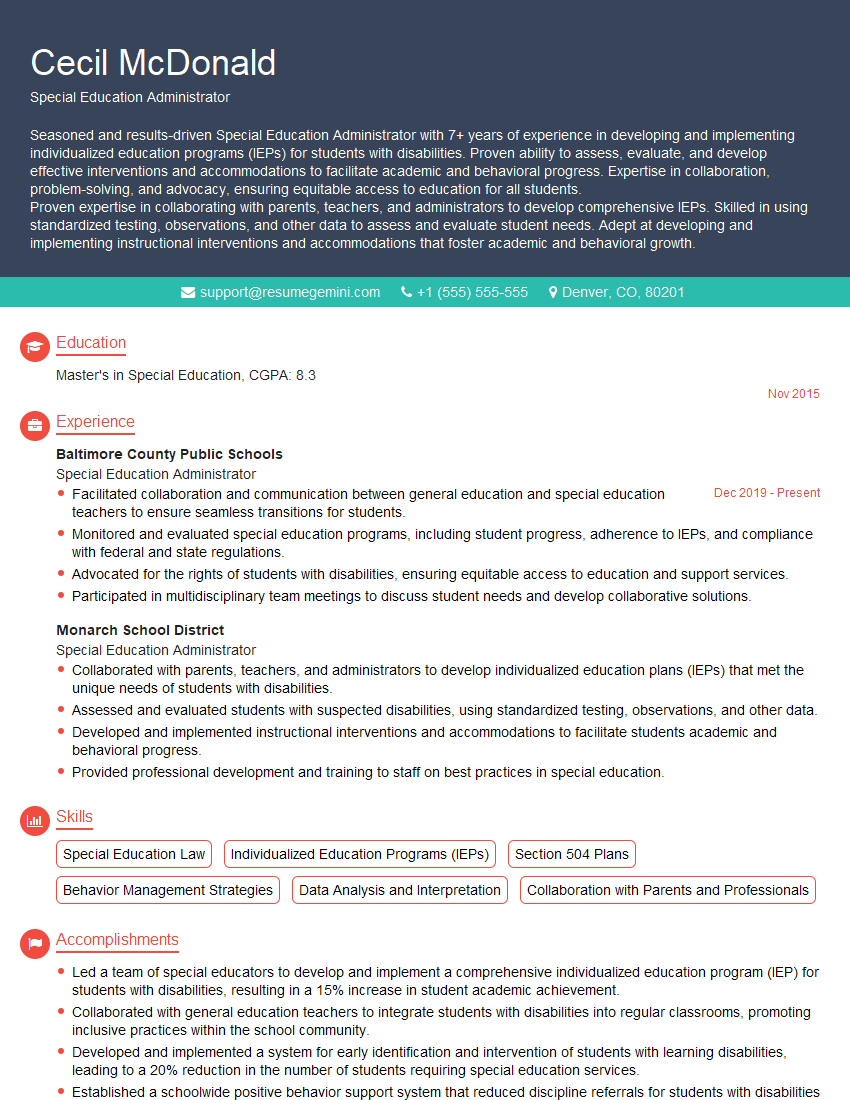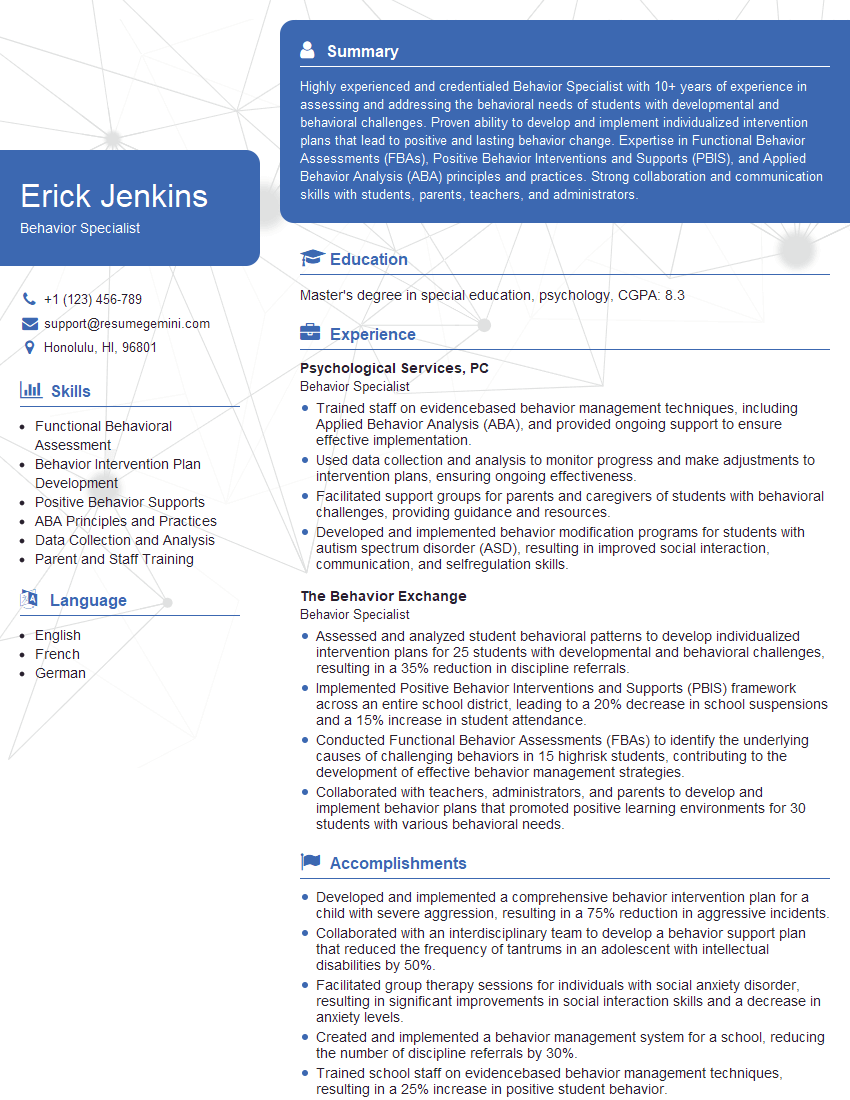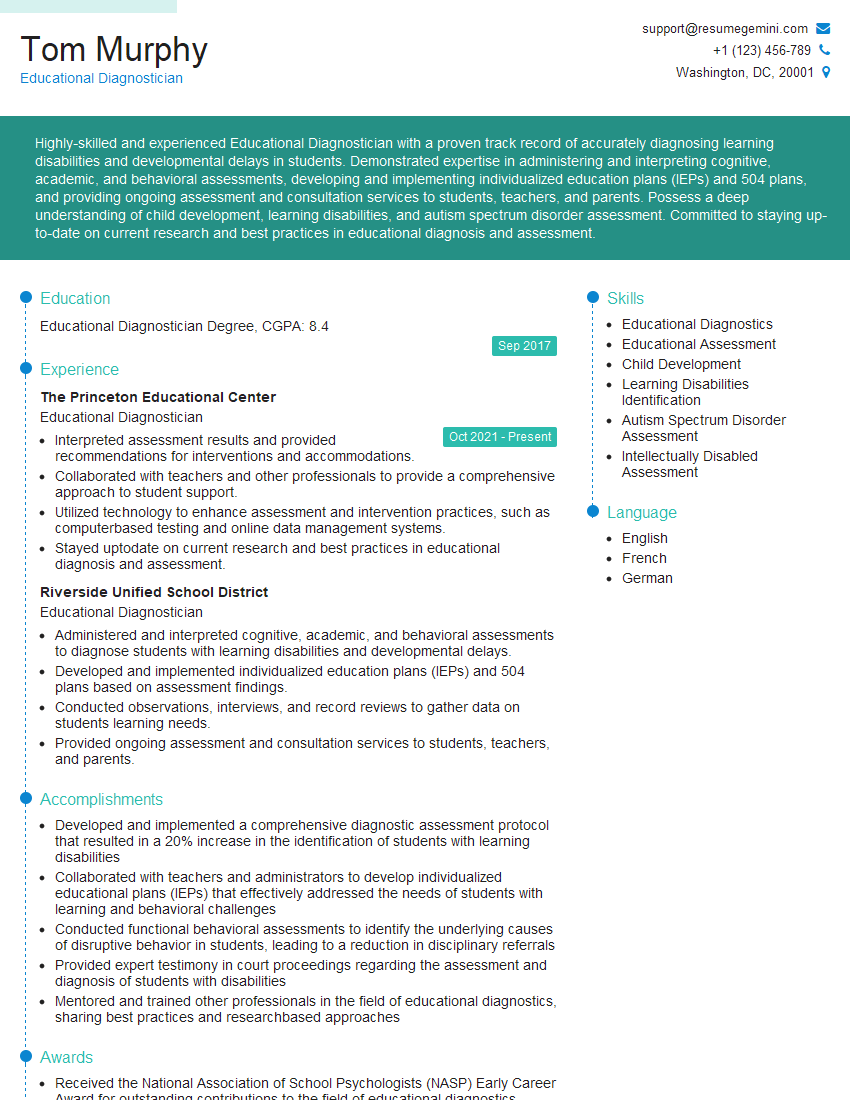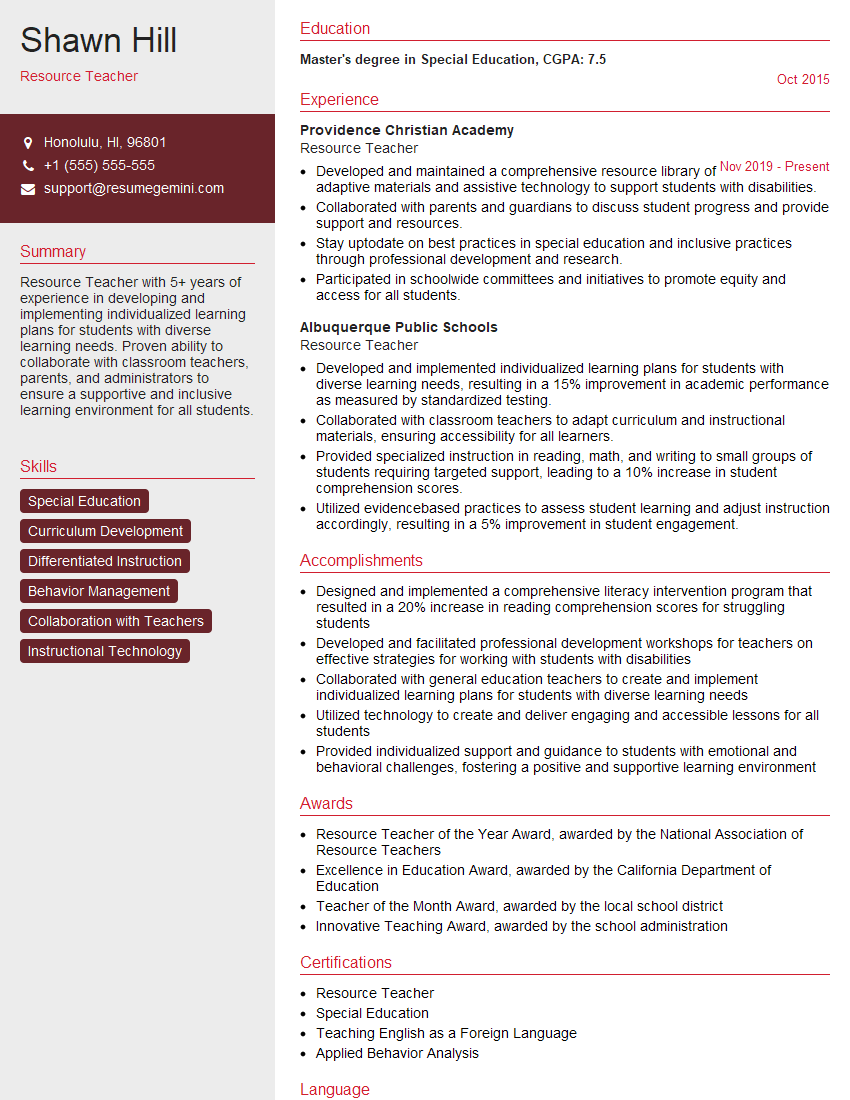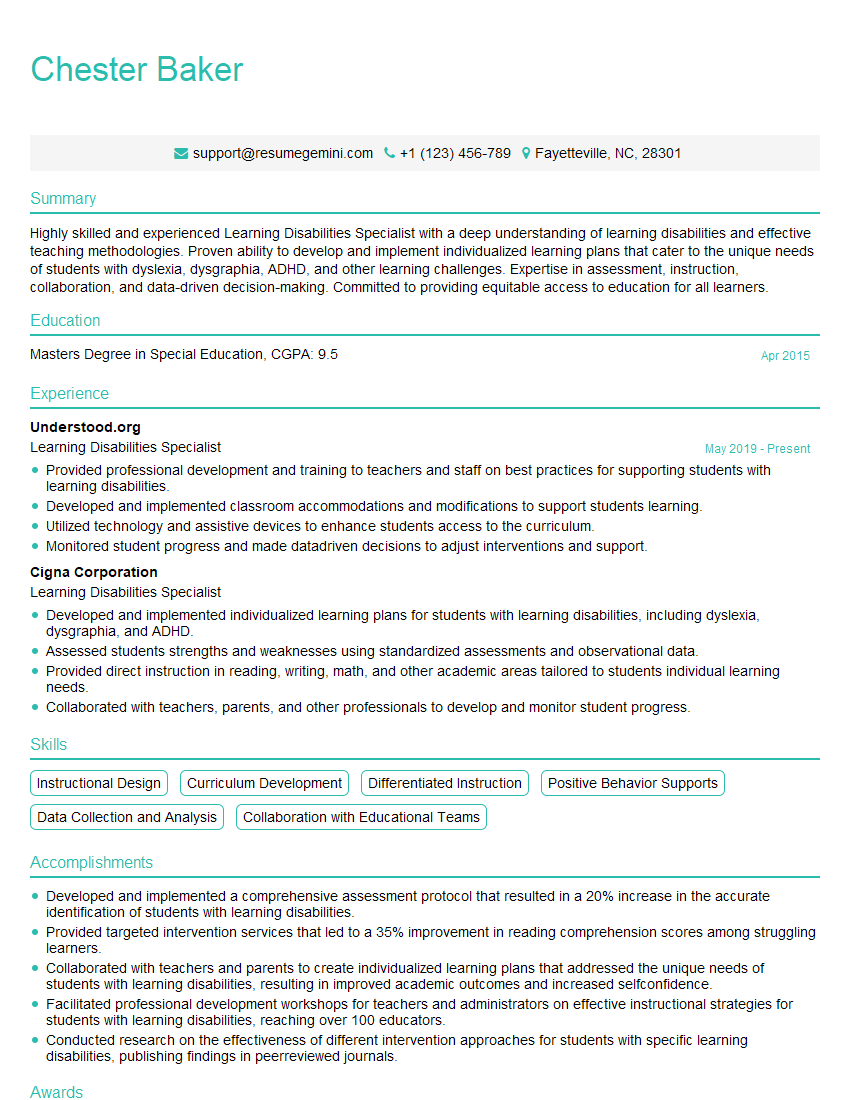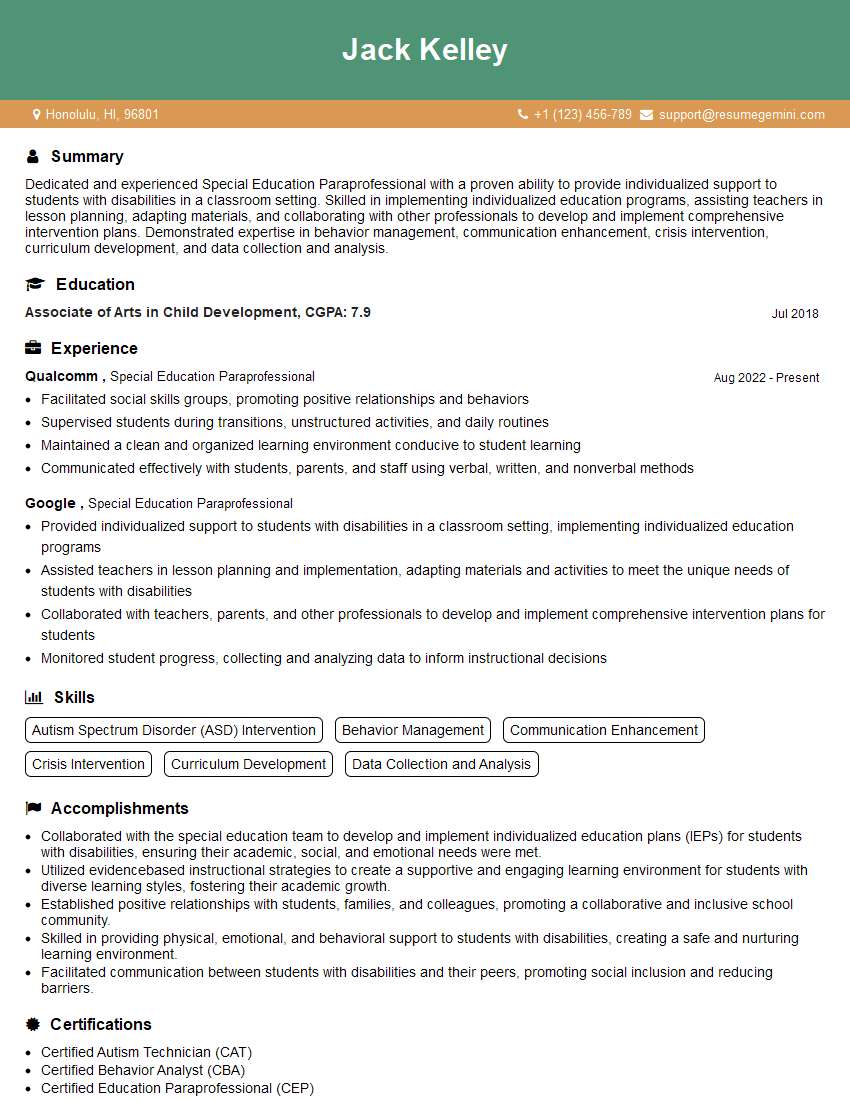Preparation is the key to success in any interview. In this post, we’ll explore crucial I.E.P. Writing interview questions and equip you with strategies to craft impactful answers. Whether you’re a beginner or a pro, these tips will elevate your preparation.
Questions Asked in I.E.P. Writing Interview
Q 1. Explain the purpose of an Individualized Education Program (IEP).
An Individualized Education Program (IEP) is a legally mandated document that outlines the specific educational needs of a student with a disability and the services required to help them succeed in school. Think of it as a personalized learning blueprint, tailored to address the unique challenges and strengths of each student. It’s not a one-size-fits-all approach; rather, it’s a customized plan designed to ensure the student receives the support they need to access the general curriculum and make progress towards their individual goals.
Q 2. Describe the key components of an IEP.
Key components of an IEP include:
- Present Levels of Performance (PLP): A description of the student’s current academic, social, and developmental skills. This forms the baseline for measuring progress.
- Goals and Objectives: Measurable, short-term objectives that break down larger, long-term goals into manageable steps. These objectives specify what the student will achieve and how progress will be measured.
- Special Education and Related Services: Specific services the student will receive, such as speech therapy, occupational therapy, or assistive technology. It clearly outlines who provides these services, how often, and for how long.
- Evaluation Procedures: How the student’s progress towards goals will be monitored and documented. This often involves regular assessments and progress reports.
- Placement: Where the student will receive their education (general education classroom, resource room, etc.). The IEP team considers the least restrictive environment (LRE) principle, aiming to keep the student in a general education setting as much as possible.
- Participation with Non-disabled Peers: How the student will be included in activities with their non-disabled peers. This might involve modifications or accommodations in the general education classroom or participation in extracurricular activities.
- Transition Services: For students aged 16 and older (or younger, if appropriate), plans for transitioning to post-secondary education, employment, or independent living.
Q 3. What are the legal requirements for IEP development and implementation under IDEA?
The Individuals with Disabilities Education Act (IDEA) mandates several legal requirements for IEP development and implementation. These include:
- Free Appropriate Public Education (FAPE): All eligible students with disabilities are entitled to a free and appropriate public education tailored to their unique needs.
- Least Restrictive Environment (LRE): Students with disabilities must be educated in the setting that is most similar to that of non-disabled peers, while still providing the necessary support.
- Parent Participation: Parents must be active participants in all stages of the IEP process, from initial evaluation to annual reviews. Their input is critical.
- Due Process Procedures: Parents have the right to due process if they disagree with any aspect of their child’s IEP.
- Individualized and Appropriate Goals and Objectives: IEPs must be individualized and contain measurable, attainable, and relevant goals and objectives.
- Regular Reviews and Evaluations: IEPs must be reviewed annually, and progress toward goals must be carefully monitored.
Failure to comply with these requirements can result in legal action.
Q 4. How do you ensure parental involvement in the IEP process?
Ensuring parental involvement is paramount. I always start by building a strong, collaborative relationship with parents. This involves:
- Open Communication: Regular communication through phone calls, emails, and face-to-face meetings. I explain the IEP process clearly and answer all their questions patiently.
- Active Listening: I actively listen to parents’ concerns, perspectives, and aspirations for their child. I value their insights as they know their child best.
- Shared Decision-Making: I present options and collaboratively make decisions about the IEP goals, services, and placement, ensuring the parents feel heard and respected.
- Providing Information in an Accessible Format: I ensure all communication is understandable and available in their preferred language and format (e.g., written documents, translated materials).
- Parent Training and Support: I provide parents with resources and training to help them understand their child’s disability and advocate for their needs.
For example, I recently worked with a family who were initially hesitant about their child’s placement. By actively listening to their concerns and presenting different options, we collaboratively developed a plan that addressed their anxieties while ensuring their child received the appropriate support.
Q 5. Explain the difference between IEP goals and objectives.
IEP goals and objectives are related but distinct. A goal is a broad, long-term statement of what the student will achieve. An objective is a smaller, more specific step towards achieving that goal. Think of it like climbing a mountain: the goal is to reach the summit, while objectives are the individual campsites you reach along the way.
For example, a goal might be: “Student will improve reading comprehension.” This is broad. Objectives would break this down into measurable steps, such as: “Student will accurately answer 8 out of 10 comprehension questions on grade-level passages by [date].”
Q 6. How do you write measurable and attainable IEP goals?
Measurable and attainable IEP goals follow the SMART framework: Specific, Measurable, Achievable, Relevant, and Time-bound.
- Specific: Clearly define what the student will be able to do. Avoid vague terms.
- Measurable: Use quantifiable data to track progress. This might involve percentages, scores, frequency, or duration.
- Achievable: Set goals that are challenging but attainable for the student, given their current abilities and support.
- Relevant: Ensure goals align with the student’s individual needs and the general curriculum.
- Time-bound: Set a deadline for achieving the goal. This provides a timeframe for monitoring progress.
Example: Instead of “Improve math skills,” a better goal would be: “Student will correctly solve 80% of single-digit multiplication problems with 80% accuracy within 1 minute by [date].” This is specific, measurable, achievable, relevant, and time-bound.
Q 7. Describe your experience with developing IEP goals in different academic areas (reading, math, etc.).
I have extensive experience developing IEP goals across various academic areas. In reading, I’ve focused on goals related to phonemic awareness, fluency, vocabulary, and comprehension. For example, for a student struggling with fluency, a goal might be: “Student will read a grade-level passage aloud with 90 words per minute and 95% accuracy by [date].”
In math, goals have centered on number sense, calculation skills, problem-solving, and application of concepts. A goal for a student struggling with multiplication might be: “Student will accurately solve 20 multiplication problems involving single and double-digit numbers with 90% accuracy in 10 minutes by [date].”
In writing, goals often target areas such as sentence structure, grammar, organization, and mechanics. For a student struggling with organization, a goal might be: “Student will write a 5-paragraph essay with a clear introduction, body paragraphs, and conclusion, demonstrating logical organization by [date].”
The key is to assess the student’s current skills, identify areas of need, and create goals that are both challenging and attainable within a reasonable timeframe. I also carefully consider the student’s strengths and interests to make the learning process more engaging and motivating.
Q 8. How do you select appropriate accommodations and modifications for students with IEPs?
Selecting appropriate accommodations and modifications for students with IEPs is a crucial step in ensuring their success. It’s not a one-size-fits-all approach; instead, it requires careful consideration of the student’s individual needs, strengths, and learning style. We start by thoroughly reviewing the student’s Present Levels of Performance (PLP) to identify specific areas of struggle and the root causes.
For example, if a student struggles with reading comprehension due to processing speed difficulties, we might consider accommodations such as providing extended time on tests, using audiobooks, or breaking down assignments into smaller, manageable chunks. Modifications, on the other hand, alter the content or expectations. If the student is significantly behind in reading, a modification might involve adjusting the reading level of assigned texts.
The process involves collaboration with the IEP team (parents, teachers, specialists) to brainstorm and agree upon the most effective interventions. We always consider the least restrictive environment – ensuring accommodations and modifications are implemented to support success within the general education classroom as much as possible. Data is key; we regularly monitor the effectiveness of interventions and adjust as needed based on student progress.
- Accommodations: Changes in *how* a student learns (e.g., extra time, preferential seating).
- Modifications: Changes in *what* a student learns (e.g., modified assignments, adjusted curriculum).
Q 9. What strategies do you use to monitor student progress toward IEP goals?
Monitoring student progress toward IEP goals is an ongoing process, not a one-time event. We utilize a variety of strategies to track progress, ensuring that interventions are effective and adjustments are made as necessary. This involves regularly collecting both formative and summative data. Formative data, collected through observations, classwork, and informal assessments, provides ongoing feedback. Summative data, obtained through formal tests and projects, provides a snapshot of the student’s overall progress toward the established goals.
For instance, if a student’s IEP goal focuses on improving reading fluency, we might track their words-per-minute (WPM) rate using timed readings throughout the year. We also look for qualitative improvements – does the student read more smoothly and with greater expression? This multifaceted approach provides a comprehensive understanding of the student’s progress. We use data analysis to inform our decision-making; If the student isn’t making progress as anticipated, we review the interventions and make necessary changes. This might include adjusting the intensity of the intervention, introducing a new strategy, or modifying the goal itself. Regular progress reports are shared with parents and the IEP team.
Q 10. How do you modify assessments to accommodate student needs?
Modifying assessments to accommodate student needs is crucial to accurately measure their understanding, rather than their ability to navigate the format of a test. The key is to ensure the assessment aligns with the student’s IEP goals and reduces barriers to demonstrating their knowledge. We consider the student’s specific learning needs, such as visual or auditory processing challenges, physical limitations, or cognitive differences.
For example, a student with a visual impairment might be provided with a large-print version of the test, or a student with ADHD may benefit from a distraction-reduced environment. We might allow a student extra time, break down complex questions into simpler parts, or permit the use of assistive technology. It is imperative that modifications don’t change the fundamental content or skills being assessed; it’s about making the format accessible.
We always ensure that any modifications made are documented and clearly communicated to the IEP team. This transparency is important for maintaining consistency and ensuring the fairness of the assessment.
Q 11. Describe your experience with writing IEP present levels of performance (PLP).
Writing effective Present Levels of Performance (PLP) statements is a critical component of the IEP process. The PLP provides a concise and data-driven description of the student’s current academic, functional, and behavioral performance. It acts as the foundation upon which the IEP goals are built.
My approach starts with gathering data from multiple sources: teacher observations, standardized test scores, classroom assessments, and input from related service providers (therapists, counselors). I then analyze this data to identify patterns and strengths and weaknesses. The PLP is written using objective language, avoiding subjective terms or value judgments. It should be specific, quantifiable, and measurable. For example, instead of writing “John struggles with reading,” a stronger PLP statement would be “John reads at a 2nd-grade level, demonstrating difficulty with decoding multisyllabic words and comprehension of complex texts.”
The PLP needs to be clear, concise, and readily understood by all members of the IEP team and the parents. It shouldn’t be overly lengthy or filled with jargon. The goal is to paint a clear picture of the student’s current abilities and needs. This accurate portrayal will directly influence the development of appropriate IEP goals and interventions.
Q 12. How do you address behavioral concerns in an IEP?
Addressing behavioral concerns in an IEP requires a multi-faceted approach that focuses on understanding the root causes of the behavior and implementing effective interventions. It’s vital to avoid labeling the student; instead, we analyze the context of the behavior and its function.
We utilize a functional behavioral assessment (FBA) to determine why a student is exhibiting certain behaviors. This might involve observing the student in various settings, interviewing teachers and parents, and reviewing school records. The FBA helps us identify triggers, maintaining factors, and the function of the behavior (e.g., attention-seeking, escaping a task). Once the function is understood, we can develop a behavior intervention plan (BIP) that addresses the underlying cause. This plan might involve positive behavioral supports, such as reward systems, teaching alternative coping mechanisms, and modifying the environment to reduce triggers. The BIP must be clearly defined, with specific strategies, data collection methods, and criteria for success. Regular monitoring and adjustments are crucial to ensure the BIP’s effectiveness.
Q 13. How do you collaborate with other professionals (e.g., teachers, therapists) during the IEP process?
Collaboration is the cornerstone of effective IEP development and implementation. I foster strong working relationships with all members of the IEP team, including general education teachers, special education teachers, therapists (occupational, physical, speech), counselors, and most importantly, the parents. My collaboration style prioritizes open communication, shared decision-making, and a focus on the student’s best interests.
We use a variety of communication strategies: regular meetings, email correspondence, shared online platforms, and informal discussions to ensure everyone is informed and involved. Before IEP meetings, I gather data and input from all team members to inform the discussion. During the meetings, I actively listen to everyone’s perspectives and foster a collaborative environment where everyone feels comfortable sharing their insights and concerns. Following the meeting, I distribute the IEP documents and ensure that everyone understands their roles and responsibilities in implementing the plan. This ongoing communication and collaboration allows us to continually monitor the student’s progress and adapt the IEP as needed.
Q 14. Explain your process for identifying students who may require an IEP.
Identifying students who may require an IEP is a multi-step process that begins with universal screening and ongoing monitoring of student performance. We utilize a variety of assessment tools and methods, including formative and summative assessments, teacher observations, and input from parents. If a student exhibits significant discrepancies between their expected performance and actual performance in one or more areas, further evaluation might be warranted.
A key aspect is to look beyond just academic performance. We also consider social-emotional development, adaptive behavior skills, and any physical or health concerns that could impact the student’s learning. We look for patterns of behavior or learning difficulties that persist over time despite interventions. If concerns remain after utilizing appropriate interventions in the general education classroom, a referral for a comprehensive evaluation might be made. The evaluation is a thorough process involving multiple professionals to accurately assess the student’s strengths and needs. Based on the evaluation results, the IEP team determines whether the student meets eligibility criteria for special education services.
Q 15. What is your experience with different types of disabilities and their impact on learning?
My experience encompasses a wide range of disabilities, including learning disabilities (like dyslexia and dysgraphia), ADHD, autism spectrum disorder, speech and language impairments, emotional and behavioral disorders, and physical disabilities. Understanding the impact of these disabilities on learning requires recognizing how each uniquely affects a student’s cognitive processing, social-emotional development, and physical abilities. For example, a student with dyslexia might struggle with decoding written text, affecting reading comprehension and written assignments. A student with ADHD might have difficulty focusing, leading to impulsivity and organizational challenges. An understanding of these varied challenges is crucial for developing effective IEPs.
I work closely with parents, teachers, therapists, and other professionals to gain a thorough understanding of each student’s strengths and needs. This multidisciplinary approach ensures a comprehensive picture of the student’s learning profile.
- Learning Disabilities: I’ve worked with numerous students with dyslexia, providing strategies like multisensory teaching and assistive technology to support reading and writing.
- ADHD: For students with ADHD, I’ve implemented strategies to manage attention, such as structured routines, frequent breaks, and organizational tools.
- Autism Spectrum Disorder: My experience includes supporting students with ASD, focusing on strategies to improve social skills, communication, and sensory regulation. This often includes collaboration with behavioral therapists and occupational therapists.
Career Expert Tips:
- Ace those interviews! Prepare effectively by reviewing the Top 50 Most Common Interview Questions on ResumeGemini.
- Navigate your job search with confidence! Explore a wide range of Career Tips on ResumeGemini. Learn about common challenges and recommendations to overcome them.
- Craft the perfect resume! Master the Art of Resume Writing with ResumeGemini’s guide. Showcase your unique qualifications and achievements effectively.
- Don’t miss out on holiday savings! Build your dream resume with ResumeGemini’s ATS optimized templates.
Q 16. How do you ensure the IEP is individualized to the student’s unique needs?
Individualizing an IEP is paramount. It’s not a one-size-fits-all document. I achieve this through a collaborative process involving the student (when appropriate), parents, teachers, and other relevant professionals. This team gathers comprehensive data through observations, assessments, and input from various sources. This data informs the creation of specific, measurable, achievable, relevant, and time-bound (SMART) goals.
For example, instead of a generic goal like “improve reading comprehension,” we’d create a goal such as: “Student will increase reading comprehension, as measured by weekly reading assessments, from 50% accuracy to 80% accuracy within one academic term.” The IEP will also outline specific strategies and accommodations to help the student achieve these goals. This might include things like preferential seating, extended time on tests, graphic organizers, or the use of assistive technology.
Regular progress monitoring is key. We track the student’s progress using data-driven assessments and adjust the IEP as needed to ensure the goals remain appropriate and effective. This iterative process guarantees the IEP remains relevant and responsive to the student’s evolving needs.
Q 17. What are some common challenges in writing IEPs and how do you overcome them?
Common challenges in IEP writing include balancing the needs of various stakeholders, ensuring the IEP is legally compliant, and accurately measuring student progress. Sometimes, disagreements arise between parents and school staff about appropriate goals or services. Another challenge is ensuring the IEP is not overly ambitious or too simplistic. Data collection can also be time-consuming.
To overcome these challenges, I use a proactive, collaborative approach. I facilitate open communication among all stakeholders, actively listening to and addressing concerns. I clearly explain the rationale behind IEP recommendations using data-driven evidence. When disagreements arise, I employ conflict-resolution strategies, focusing on finding common ground and solutions that benefit the student. To streamline the process, I utilize effective organizational tools and templates, ensuring all necessary components are addressed. I also prioritize clear and concise language to make the IEP easily understandable by all parties involved.
Q 18. Describe your familiarity with assistive technology and its role in IEP development.
Assistive technology (AT) plays a crucial role in IEP development. My familiarity extends to a wide variety of AT, including text-to-speech software, speech-to-text software, graphic organizers, adaptive keyboards, augmentative and alternative communication (AAC) devices, and specialized learning apps. I consider AT as a key component of individualized support for students with disabilities. The selection of AT is highly dependent on the student’s specific needs and learning style. The IEP should clearly outline the specific AT to be used, how it will be integrated into the student’s learning environment, and who is responsible for its implementation and maintenance.
For instance, a student with dysgraphia might benefit from a voice-recognition software to complete written assignments. A student with visual impairments might use screen readers and other specialized hardware. In every case, the selection and implementation of AT should be based on thorough assessment and should aim to support the student’s learning goals in the most effective and efficient way.
Q 19. How do you address the transition services component of an IEP?
Transition services are a critical component of IEPs for students approaching adulthood. They focus on preparing students for life after high school, including post-secondary education, vocational training, employment, and independent living. My approach involves initiating transition planning well in advance of the student’s graduation, typically beginning around age 16.
This process includes involving the student, parents, teachers, vocational counselors, and other community support personnel. We collaboratively explore the student’s interests, strengths, and post-school goals. The IEP then outlines specific transition goals and activities. For example, goals might include securing paid employment, enrolling in vocational training, or developing independent living skills. We often coordinate with local community agencies to identify resources and supports that will assist the student in achieving these goals. Regular monitoring and updates to the transition plan are vital to ensure its effectiveness.
Q 20. How do you ensure compliance with all relevant regulations and guidelines in IEP development?
Compliance with all relevant regulations and guidelines is paramount in IEP development. I maintain a thorough understanding of the Individuals with Disabilities Education Act (IDEA), state-specific regulations, and district policies. This includes understanding requirements for eligibility determination, the IEP team composition, the content required in an IEP document, parental rights, and procedural safeguards. I meticulously follow established protocols for IEP meetings, documentation, and data collection.
I regularly participate in professional development activities to stay updated on changes in legislation and best practices. I ensure every IEP I write adheres to legal and ethical standards, protecting the rights and interests of all students. Consistent review of current regulations and policies is a key aspect of my professional practice.
Q 21. Explain your experience with using data to inform IEP goal setting and progress monitoring.
Data-driven decision-making is fundamental to my approach to IEP goal setting and progress monitoring. Before creating goals, I collect data from a variety of sources, including standardized assessments, curriculum-based measurements, teacher observations, and student work samples. This comprehensive data helps me identify the student’s strengths and weaknesses and establish baseline performance levels. This data is crucial for selecting appropriate goals and measuring progress.
For example, if a student is struggling with math, I might use data from formative and summative assessments to pinpoint specific areas of difficulty (e.g., fractions, multiplication). This informs the development of targeted goals and interventions. During the year, I regularly collect data through ongoing assessments, monitoring student progress toward these goals. This progress is discussed with the IEP team, and the IEP is modified as needed to ensure the student’s needs are continually being met. If the data shows the student isn’t progressing as expected, adjustments are made to the IEP, such as modifying instructional strategies, providing additional support, or adjusting goals.
Q 22. How do you communicate effectively with parents and guardians regarding their child’s IEP?
Effective communication with parents and guardians is paramount for successful IEP implementation. I prioritize building rapport by actively listening to their concerns and perspectives, ensuring they feel heard and valued. I use clear, non-technical language, avoiding educational jargon whenever possible. I explain the IEP’s purpose, goals, and strategies in terms they can readily understand, using analogies and real-life examples to illustrate complex concepts.
For instance, if discussing a student’s reading goals, I might relate it to improving skills to read their favorite book series more easily. I also provide written summaries of our discussions and the IEP goals, ensuring accessibility through multiple means such as email, phone calls, and translated documents when needed. Regular check-in meetings are scheduled to monitor progress, address concerns, and celebrate successes. Open communication lines, including readily available contact information, are vital to sustaining a collaborative relationship.
Q 23. Describe your experience with IEP meetings and facilitation.
I have extensive experience facilitating IEP meetings, ensuring they are collaborative, productive, and respectful. My approach involves careful preparation, including reviewing the student’s data and sending pre-meeting materials to all participants. I begin by establishing a welcoming and inclusive atmosphere, clearly defining the meeting’s purpose and agenda. I employ active listening and encourage all participants—parents, teachers, specialists, and the student (when appropriate)—to share their perspectives. I guide the discussion towards consensus-building, focusing on the student’s strengths and needs.
I use visual aids, such as graphs and charts illustrating student progress, to help everyone understand the data. Throughout the meeting, I ensure that all voices are heard and that decisions are made collaboratively. Minutes are meticulously documented and distributed promptly, ensuring transparency and accountability. I’ve successfully facilitated IEPs for students with diverse needs, including autism spectrum disorder, learning disabilities, and emotional disturbances.
Q 24. How do you handle disagreements or conflicts among IEP team members?
Disagreements among IEP team members are inevitable, but constructively addressing them is crucial. My approach prioritizes respectful dialogue and collaborative problem-solving. I start by acknowledging and validating each team member’s perspective, creating a safe space for open communication. I facilitate a structured discussion, focusing on the student’s needs and ensuring all data are considered. I actively listen to understand the root cause of the disagreement, clarifying any misunderstandings or differing interpretations of data. If needed, I employ conflict-resolution techniques, such as brainstorming alternative solutions and finding common ground.
For example, if a teacher and a parent disagree on a goal’s achievability, I might suggest breaking down the goal into smaller, more manageable steps and collaboratively setting realistic timelines. If consensus is still not reached, I employ mediation techniques, ensuring fairness and equity for all involved. My goal is always to prioritize the student’s best interests while fostering positive working relationships among team members.
Q 25. What professional development activities have you undertaken related to IEP writing?
I regularly engage in professional development activities to enhance my IEP writing skills. I’ve participated in workshops on current research-based practices, effective goal-writing strategies, and the legal and ethical considerations of IEP development. I’ve also completed training on using technology effectively to create and manage IEPs. I actively seek out opportunities to stay updated on best practices through webinars, conferences, and online courses offered by organizations such as the Council for Exceptional Children (CEC).
Furthermore, I regularly review relevant literature and resources to ensure my knowledge base remains current and aligned with best practices. I also engage in peer review and mentorship activities, learning from colleagues and sharing best practices. I maintain a professional portfolio documenting my participation in these activities and showcasing my continual commitment to professional growth in the field of special education.
Q 26. Describe your experience with writing IEPs for students with specific learning disabilities.
I have extensive experience writing IEPs for students with specific learning disabilities (SLDs). My approach focuses on a thorough assessment of the student’s strengths and weaknesses, using multiple sources of data, including standardized tests, classroom observations, and teacher input. I work closely with the student’s teachers and specialists to identify specific learning challenges and to determine effective accommodations and modifications. The IEP goals are carefully crafted to be measurable, achievable, relevant, and time-bound (SMART goals).
For example, for a student with a reading disability, I might focus on improving phonological awareness, fluency, and reading comprehension. Goals would include specific, measurable targets such as increasing reading fluency by X words per minute within Y weeks. The IEP would also outline specific accommodations, such as providing extra time on tests, using audiobooks, or utilizing assistive technology. Regular progress monitoring ensures the effectiveness of the interventions and allows for adjustments as needed. I ensure all interventions align with evidence-based practices and are tailored to the individual needs of the student.
Q 27. How do you differentiate instruction based on the information provided in the IEP?
Differentiated instruction is crucial for students with IEPs, ensuring they receive tailored support to meet their unique learning needs. I meticulously review the student’s IEP, paying close attention to the stated goals, accommodations, and modifications. This information guides my instructional strategies, ensuring the content, process, product, and learning environment are adjusted to meet the student’s specific learning style and needs.
For example, if an IEP specifies that a student requires visual aids to understand complex concepts, I would incorporate graphic organizers, diagrams, and multimedia presentations into my lessons. If a student needs additional time to complete tasks, I would provide extended time limits on assignments and tests. I also adjust the complexity of tasks, offering scaffolding and support for students who need it while providing opportunities for extension for students who are ready for a challenge. Regular progress monitoring helps me adjust my approach as needed, ensuring the differentiated instruction is effective in supporting the student’s progress towards their IEP goals.
Q 28. What technology are you proficient in using to create and maintain student IEPs?
I am proficient in using several technologies to create and maintain student IEPs. I am experienced with various online IEP management systems, such as [mention specific systems used, e.g., Infinite Campus, PowerSchool]. These systems allow for collaborative IEP development, secure data storage, and easy access for all stakeholders. I’m also skilled in using word processing software (e.g., Microsoft Word, Google Docs) to create well-organized and visually appealing IEP documents. Furthermore, I effectively utilize assistive technologies and other software to aid in creating accessible IEPs that accommodate diverse learning needs.
Beyond the software itself, I am adept at using technology to facilitate communication with families and other stakeholders. Utilizing email, video conferencing, and secure messaging platforms, I ensure timely dissemination of information and efficient collaboration. I am committed to ongoing professional development in the application of technology to special education to enhance the efficacy of IEP development and implementation.
Key Topics to Learn for I.E.P. Writing Interview
Mastering these key areas will significantly boost your confidence and preparedness for your IEP Writing interview. Remember, the goal isn’t just rote memorization, but demonstrating a deep understanding and ability to apply these concepts.
- Understanding IEP Components: Thoroughly grasp the structure and purpose of each section within an Individualized Education Program (IEP), including Present Levels of Performance (PLP), goals, accommodations, and services.
- Legal Frameworks and Compliance: Familiarize yourself with relevant federal and state laws (e.g., IDEA) impacting IEP development and implementation. Understand the legal ramifications of improperly written IEPs.
- Data Analysis and Goal Setting: Learn how to effectively analyze student data (academic, behavioral, etc.) to inform the creation of measurable and attainable IEP goals. Practice translating assessment results into actionable steps.
- Collaboration and Communication: Practice articulating your reasoning and decisions clearly and concisely. Understand the dynamics of the IEP team and how to effectively collaborate with parents, teachers, and other professionals.
- IEP Writing Techniques: Develop proficiency in writing clear, concise, and legally sound IEP goals and objectives. Practice using specific, measurable, achievable, relevant, and time-bound (SMART) goal writing techniques.
- Addressing Diverse Learning Needs: Demonstrate your understanding of how to adapt IEP goals and accommodations for students with diverse learning needs, including students with disabilities across a spectrum of severity.
- Problem-Solving in IEP Development: Be prepared to discuss scenarios requiring creative problem-solving within the IEP framework. Consider how you would address challenges related to goal attainment, resource allocation, or team disagreements.
Next Steps
Proficiency in IEP writing is highly valued and opens doors to rewarding careers in education. A strong understanding of IEP development demonstrates your commitment to student success and your ability to work collaboratively within a team. To maximize your job prospects, creating an ATS-friendly resume is crucial. ResumeGemini can help you build a professional and impactful resume that highlights your skills and experience. Take advantage of our resources and examples of resumes tailored to IEP Writing positions to showcase your expertise effectively. You’ve got this!
Explore more articles
Users Rating of Our Blogs
Share Your Experience
We value your feedback! Please rate our content and share your thoughts (optional).
What Readers Say About Our Blog
Hi, I’m Jay, we have a few potential clients that are interested in your services, thought you might be a good fit. I’d love to talk about the details, when do you have time to talk?
Best,
Jay
Founder | CEO
